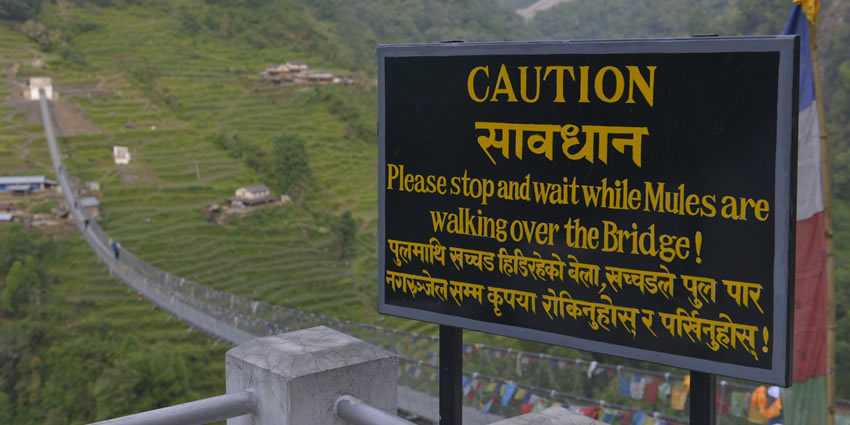Annapurna Base Camp Trek Overview

Trek to Annapurna Base Camp is one of the most famous treks in Nepal. It is quite a comfortable and lower trek than other high-altitude treks in Nepal. This trek combines distinct terrain, history, culture, and wildlife along with the most magnificent and nearest view of the entire Annapurna range, Machhapuchhre, Hiunchuli, and Dhaulagiri.
During the Spring season, the trekking trail showcases many beautiful waterfalls, the deepest Gorge Kali Gandaki river, gorgeous flowers, including Rhododendron, the national flower of Nepal.
There are various places to choose from while starting the trek. You can select and plan an itinerary on whether to pass through Ghandruk village or not. The trail is the same from Choomrong village onwards, but you can decide to either include or exclude Ghorepani village, Poon Hill viewpoint, and Ghandruk village. Poon Hill is a viewpoint for the sunrise and sunset view of mountains of the Annapurna region and other peaks.
And, you will get to learn about the people of the Gurung community at Ghandruk; also, you can explore the museum there.
Also, the route of the Annapurna base camp trek passes through Machhapuchhre Base Camp, which is a fantastic trek to see two base camps in one trip!
Also, it can be connected with the full Annapurna circuit trek, which welcomes the most number of tourists in Nepal.
Trip Highlights
- Magnificent and friendly view of Annapurna, Machhapuchhre, and Dhaulagiri
- Kali Gandaki is the deepest gorge
- Lush Forests of Oaks and Rhododendrons
- A glimpse of Nepalese mountainside rural lifestyle
Best Time
You can go to the Annapurna Base Camp trek any time of the year because of its low and moderate level trek. Yet, we don’t recommend during Monsoon because there is heavy rainfall during the evening or night. Also, because of lots of leeches falling from the trees, mosquitoes on the way, possible landslides, and slippery trails.
The autumn season of Nepal is the best time to explore this trek. The dry season of autumn offers a clear blue sky and average temperature but the very crowd.
You could either go on a starting of the season or ending of the season if you would like it to be quieter but with a beautiful view.
Itinerary
2/3 ways take to the base camp of Annapurna. You can start your trek from different starting points, and you can reach Choomrong from different side trip villages. The side trip villages are Ghandrk, Ghorepani, and some others. From Choomrong, it is the same way to reach base camp.
You can also make the starting point and returning point at different places to experience two different ways. Of course, taking different routes on a single trek needs some 2-3 days of extra time.
Here I am going to share a regular itinerary that most people follow to do the Annapurna base camp trek via Ghorepani and Poon Hill.
- Day 01: Tourist bus drive from Kathmandu to Pokhara. 6-7 hours.
- Day 02: Drive to Nayapul & trek to Tikhedhunga (1,480 m). 5 hours.
- Day 03: Tikhedhunga to Ghorepani(2,870 m), trekking up for 5 hours.
- Day 04: Ghorepani village to Tadapani(2,630 m) trekking up for 6 hours. {Early Morning Poon Hill Trip }.
- Day 05: Trekking up from Tadapani to Chomrong village (2,210 m). 5 hours.
- Day 06: Chomrong to Himalaya (3,560 m), trekking up for 6 hours.
- Day 07: Trekking from Himalaya to Annapurna Base Camp (4,130 m). 7 hours.
- Day 08: Annapurna Base Camp to Bamboo (2,310 m), trekking down for 6 hours.
- Day 09: Trekking down from Bamboo to Jhinu Danda (1,700 m). 5 hours.
- Day 10: Trekking down from Jhinu Nayapul and Drive to Pokhara. 6 hours.
- Day 11: Tourist bus drive back from Pokhara to Kathmandu. 7-8 hours.
Necessary Trekking Permits
- The Annapurna Conservation Area Project (ACAP) Permit.(For SAARC nationals: Nrs.300 & For Others: Nrs.3000 )
- Trekker’s Information Management System (TIMS) card (NRS. 2000)
Equipment
ABC is the moderate level trek, so that it’s not necessary to collect and buy climbing types of equipment for this trek.
- A lightweight trekking boots
- Some pairs of liner socks, & under wears
- Down jacket, trekking pant, and sleeping bag
- T-shirts, trousers, and a set of thermals
- Pairs of Gloves, woolen hat, & Sunglasses
- A First aid kit including Diamox
- Toiletries